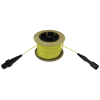Used Solinst Levelogger App Interface
The Levelogger App Interface uses Bluetooth® wireless technology to connect Series 5 dataloggers to an Apple® or Android™ smart device.
Features
- Communicate to Leveloggers wirelessly
- Eliminate the need to bring a laptop to the field
- View real-time readings, or download and e-mail logged data files
- Free ground shipping
- Expedited repair and warranty service
- Lifetime technical support
- More
The Levelogger 5 App Interface for the Levelogger Series uses Bluetooth® wireless technology to connect a Solinst datalogger to an Apple® or Android™ smart device. Once connected, the user can view data and program the datalogger using the Levelogger App. The App Interface is compatible with Levelogger’s Direct Read Cable or Adaptor, LevelVent Wellhead, or AquaVent Wellhead Connector Cable.
The App Interface is compact in design, and is easily transported. It uses four 1.5V AA lithium batteries that are easily replaced. The Interface has a power button to turn it on and off, and there is an auto-off after 10 minutes of inactivity. A LED light indicates its status.
The Bluetooth® word mark and logos are registered trademarks owned by Bluetooth SIG, Inc. and any use of such marks by Solinst Canada Ltd. is under license.
®Apple is a trademark of Apple Inc., registered in the U.S. and other countries. App Store is a service mark of Apple Inc. iOS is a trademark or registered trademark of Cisco in the U.S. and other countries and is used under license.
Android is a trademark of Google Inc.
- Compatibility: Levelogger 5 Series dataloggers, LevelVent 5 and AquaVent 5, as well as previous versions of the LevelVent and AquaVent, and Levelogger Edge Series dataloggers
- IP Rating: IP64 (dust and splash resistant)
- Materials: Black Delrin, 316 stainless steel
- Operating Temperature: -20 C to + 50 C
- Batteries: 4 x 1.5V AA replaceable lithium batteries
- Battery Life: 500 full Levelogger downloads @ 21 C
- Size: 2.25" (57mm) diameter x 4.875" (124mm) length
- Weight: 13.7 oz. (388g)
In The News
Climate Change and Microplastics: Monitoring Lake Champlain
Most people go to Lake Champlain for its exceptional views and thrilling boating, but it’s also home to a wide variety of interesting aquatic research projects. From studying microplastics to thermal dynamics of the lake, Timothy Mihuc, director of the Lake Champlain Research Institute (LCRI) at the State University of New York at Plattsburgh (SUNY Plattsburgh), has spent his career studying aquatic ecosystems. As an aquatic biologist, he’s the main investigator on Lake Champlain’s research studies while also managing their grants, employees, and their hands-on buoy work. Over the years, LCRI has received a number of environmental grants that aid in its monitoring research.
Read MoreCurrent Monitoring after the Francis Scott Key Bridge Collapse
On March 26th, according to The Baltimore Sun , a 984-foot, 112,000-ton Dali lost propulsion and collided with a support column of the Francis Scott Key Bridge, collapsing the structure. Soon after the event, search and rescue, salvage crews, and other emergency responders were mobilized after the collision. As salvage efforts progressed in early April, NOAA’s Center for Operational Oceanographic Products and Services (CO-OPS) responded to a request for real-time tidal currents data and deployed a current monitoring buoy—CURBY (Currents Real-time BuoY)—into the Patapsco River north of the Francis Scott Key Bridge.
Read MoreSoundscapes of the Solar Eclipse: Citizen Science Supporting National Research
On April 8, 2024, millions of people around the world had their eyes glued to the sky to witness a historic cosmic event. The total solar eclipse captured the headlines and the minds of many who became eager to gaze at the heavens as the sky went dark for a few minutes. However, not everyone used their sense of sight during the eclipse, some were listening to the sounds of the natural world around them as the light faded from above. The Eclipse Soundscape Project is a NASA-funded citizen science project that focuses on studying how the annular solar eclipse on October 14, 2023, and the April 8, 2024 total solar eclipse impacted life on Earth. The project revisits an initiative from the 1930s that showed animals and insects are affected by solar eclipses.
Read More












